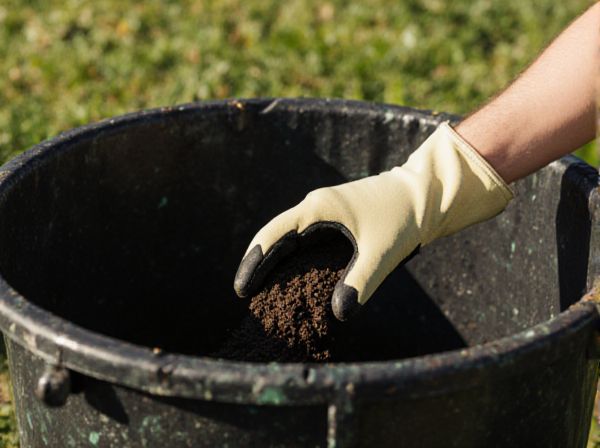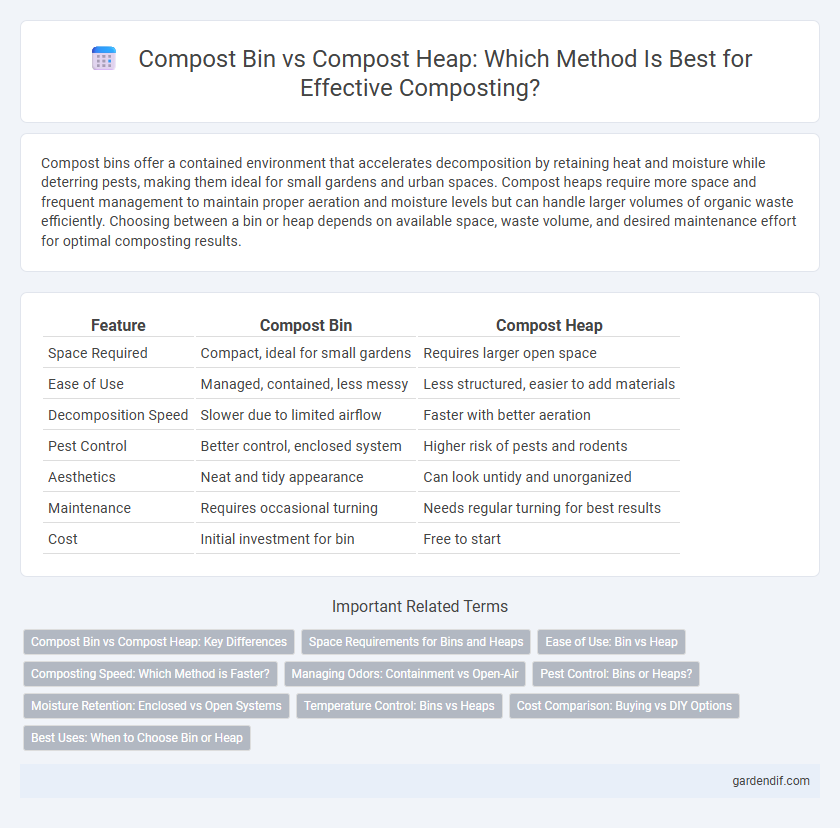
Compost Bin Use vs Compost Heap Use Illustration
Compost bins offer a contained environment that accelerates decomposition by retaining heat and moisture while deterring pests, making them ideal for small gardens and urban spaces. Compost heaps require more space and frequent management to maintain proper aeration and moisture levels but can handle larger volumes of organic waste efficiently. Choosing between a bin or heap depends on available space, waste volume, and desired maintenance effort for optimal composting results.
Table of Comparison
| Feature | Compost Bin | Compost Heap |
|---|---|---|
| Space Required | Compact, ideal for small gardens | Requires larger open space |
| Ease of Use | Managed, contained, less messy | Less structured, easier to add materials |
| Decomposition Speed | Slower due to limited airflow | Faster with better aeration |
| Pest Control | Better control, enclosed system | Higher risk of pests and rodents |
| Aesthetics | Neat and tidy appearance | Can look untidy and unorganized |
| Maintenance | Requires occasional turning | Needs regular turning for best results |
| Cost | Initial investment for bin | Free to start |
Compost Bin vs Compost Heap: Key Differences
Compost bins offer controlled environments that accelerate decomposition and reduce pests, making them ideal for urban settings, while compost heaps provide larger capacity and natural aeration suited for rural areas. Bins typically promote faster heat retention, speeding up organic matter breakdown, whereas heaps rely on manual turning for aeration and longer processing times. Choosing between a compost bin and heap depends on space availability, desired composting speed, and maintenance preference.
Space Requirements for Bins and Heaps
Compost bins typically require less space than compost heaps, making them ideal for small gardens or urban areas with limited room. Compost heaps, while requiring more area, allow for larger volumes of organic waste and often benefit from better aeration due to their open structure. Choosing between a bin or heap depends on available space and the desired scale of composting activity.
Ease of Use: Bin vs Heap
Compost bins offer a more organized and contained space, making them easier to manage and less prone to pests compared to compost heaps. The enclosed design of bins simplifies turning and aerating the compost, improving decomposition efficiency without requiring large garden areas. In contrast, compost heaps demand more physical effort to maintain and may attract unwanted wildlife due to their open structure.
Composting Speed: Which Method is Faster?
Compost bins accelerate decomposition by providing better insulation and aeration, maintaining optimal moisture and temperature levels that speed up microbial activity. In contrast, compost heaps decompose more slowly due to less controlled conditions and potential moisture imbalances. Research shows compost bins can reduce composting time by 25-50% compared to traditional heaps.
Managing Odors: Containment vs Open-Air
Compost bins offer superior odor management through containment, reducing the release of unpleasant smells by limiting airflow and retaining heat necessary for microbial activity. In contrast, compost heaps rely on open-air exposure, which allows for better aeration but can lead to inconsistent odor control and potential nuisance in residential areas. Proper management in bins involves regular turning and moisture control to prevent anaerobic conditions, while heaps require strategic placement and layering to minimize odor emissions.
Pest Control: Bins or Heaps?
Compost bins provide a contained environment that significantly reduces access for pests such as rodents and raccoons compared to open heaps, which are more vulnerable to infestation due to their exposed nature. The structured design of compost bins typically includes secure lids and ventilation that balance aeration with pest deterrence, promoting efficient decomposition while minimizing nuisance wildlife. In contrast, compost heaps lack these protective features, making it essential to regularly turn and monitor the pile to discourage pests and maintain a healthy composting process.
Moisture Retention: Enclosed vs Open Systems
Enclosed compost bins retain moisture more effectively than open compost heaps, promoting faster decomposition and reducing the need for frequent watering. The sealed environment limits evaporation, creating optimal conditions for microbial activity and nutrient breakdown. In contrast, open compost heaps are prone to moisture loss due to exposure to wind and sun, necessitating regular monitoring to maintain adequate dampness for efficient composting.
Temperature Control: Bins vs Heaps
Compost bins provide better temperature control by retaining heat more effectively, accelerating the decomposition process through improved insulation and aeration management. In contrast, compost heaps often experience fluctuating temperatures due to exposure to external elements, which can slow down microbial activity and extend the composting timeline. Maintaining optimal temperature, typically between 130degF to 160degF, is crucial for pathogen kill-off and efficient organic matter breakdown, favoring bins over heaps for controlled composting environments.
Cost Comparison: Buying vs DIY Options
Buying a compost bin typically ranges from $50 to $200 depending on size and material, while DIY compost heaps cost significantly less, often under $20 using pallets or recycled materials. Commercial bins offer convenience and durability, reducing maintenance time but require upfront investment, whereas DIY heaps require more labor and space but are cost-effective and customizable. Choosing between these options depends on budget constraints, available space, and desired composting efficiency.
Best Uses: When to Choose Bin or Heap
Compost bins are ideal for small spaces and urban gardens, providing controlled decomposition and reducing pests, while heaps suit larger areas and allow faster breakdown of bulky organic waste due to increased aeration. Choose bins for kitchen scraps and limited yard waste when space and neatness are priorities; opt for heaps when managing large volumes of garden residues like leaves and branches for quicker compost production. Temperature regulation and maintenance needs also differ, with bins requiring regular turning and heaps benefiting from natural heat retention in larger masses.
Compost Bin Use vs Compost Heap Use Infographic

 gardendif.com
gardendif.com